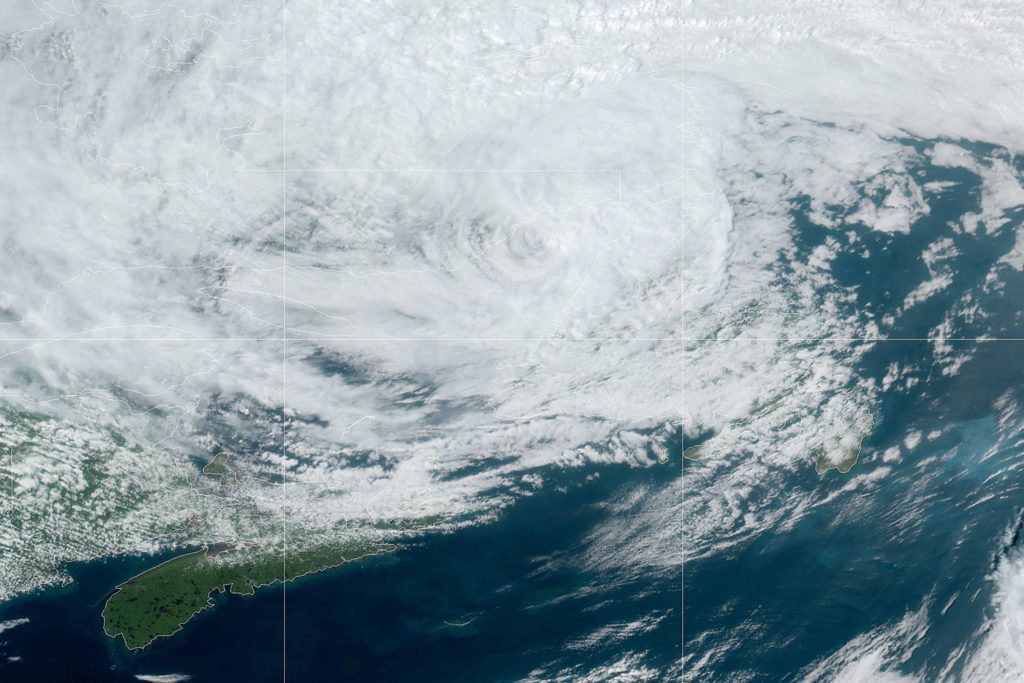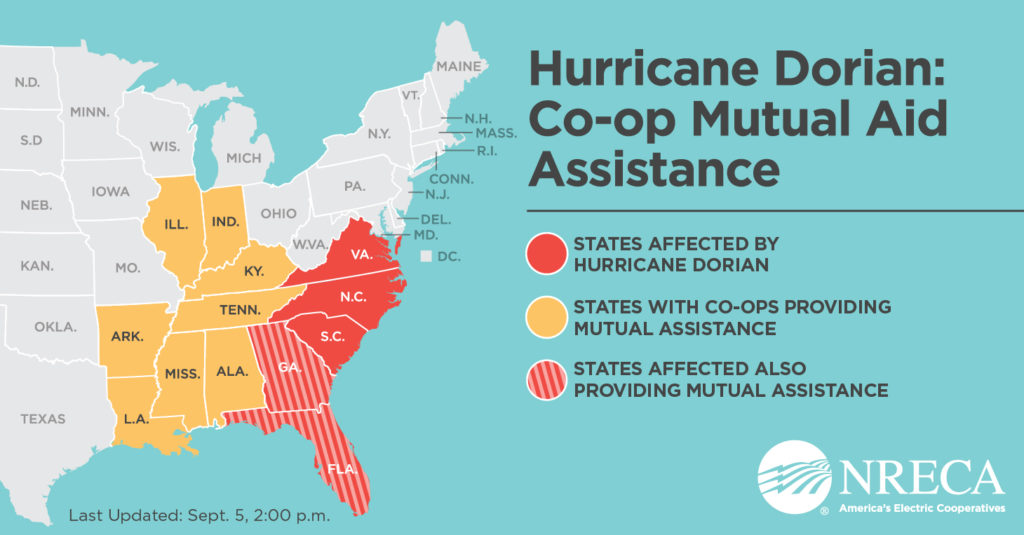
Updated: Sept. 8, 3 p.m. ET
Two days after Hurricane Dorian made landfall at Cape Hatteras, North Carolina, strafing Hatteras Island with 81 mph winds, and pushing more than six feet of storm surge into waterfront communities, most residents there have electricity restored.
North Carolina
“All the big work started early Saturday morning,” said Laura Ertle, director of public relations for Cape Hatteras Electric Cooperative. “We still have about 200 members without power, and we may find some more while crews are out working on final restoration.”
The Buxton-based co-op serves seven villages on Hatteras Island. Dorian broke one transmission pole, taking out the line that supplies power to the island. It also toppled trees and limbs across many sections of distribution lines. About 6,400 of the co-op’s 7,700 meters were without power Saturday morning, with back-up diesel generation on the island feeding the balance.
Working from just before dawn to after dusk, with the help of mutual aid, crews repaired the damaged transmission line and worked their way through affected communities replacing broken poles, stringing conductor and energizing circuits.
“We took a major hurricane landfall on Friday, and we had power restored on Saturday,” said Ertle. “That’s a huge deal for us and for our members.”
But six hours of hurricane force winds, and storm surge that flowed in from both the open Atlantic Ocean and the Pamlico Sound caused substantial damage in many Tidewater communities.
“The remaining outages are primarily in hard-hit Hyde, Beaufort and Dare counties,” said Nelle Hotchkiss, senior vice president and chief operating officer for North Carolina’s Electric Cooperatives. “Crews will continue their efforts until power is restored to all cooperative members whose homes can receive electric service.”
According to North Carolina’s statewide association, there were still about 4,500 co-op-served meters without electricity Sunday morning—a huge improvement over the 94,000 out of power early Friday, when Dorian made landfall.
“When we all returned to work early Saturday, 11,564 members remained without power. Tonight, the total number is down to 4,380,” said Heidi Jernigan Smith, manager of energy services and corporate communications for Tideland Electric Membership Corp, late Saturday.
Tideland crews, mutual aid personnel and contractors were out before dawn Sunday, pushing through more damaged portions of the co-op’s system. About 3,000 of the co-op’s outages were on the North Carolina mainland, with the balance on Ocracoke Island.
“We’re sending heavy construction crews to Dare County Sunday morning to begin distribution repairs in anticipation of transmission restoration,” said Smith.
South Carolina
Nearly 50,000 meters served by co-ops in South Carolina were without power Friday morning. By mid-morning Sunday, 1,560 remained to be reenergized, with nearly 1,500 of those in the service territory of Berkeley Electric Membership Corp.
About 1,400 were in Charleston County in Lowcountry communities, according to Leisa Stilley, manager of communications at the Moncks Corner-based distribution co-op.
“We’ve
got quite a mess on the islands, because this was our hardest-hit area,”
said Stilley Sunday morning. “We’ve got quite a few trees down, so we anticipate
having some members out through Monday.”
The co-op has had more than 500 workers supporting restoration efforts since
Sept. 5, when its first outages were reported. There were more than 34,000 outages on the
co-op’s system as Dorian lumbered up the Atlantic coastline.
A Mobile Response

Mutual aid efforts are continuing in the hardest hit areas, but most of the crews that traveled to the Southeast in preparation for post-storm restoration have been released. Those crews headed home throughout the weekend as they completed assignments in the Carolinas. Others were released by co-ops in Florida and Georgia, where damage and outages were lighter.
A Deadly Storm
Dorian pummeled the Bahamas as a Category 5 hurricane over Labor Day weekend, shifting just 40 miles in 24 hours. Sustained winds were clocked at 185 mph with gusts up to 220 mph in the hours after landfall.
The known death toll in the Bahamas is 43, but officials on the hardest-hit islands said the search of shattered communities was continuing. More than 70,000 people in the island chain were reportedly left homeless by the storm.
Dorian was a Category 2 hurricane, with sustained winds of 93 mph, when it made landfall south of Halifax, Nova Scotia, Saturday night, the storm’s fifth landfall since it first achieved hurricane status early last week. Some 350,000 residents of the Canadian province are reportedly without power.
As it continues moving toward the North Atlantic, Dorian is expected to be downgraded to post-tropical cyclone status.